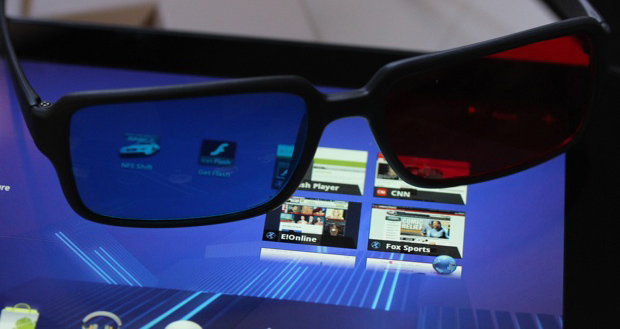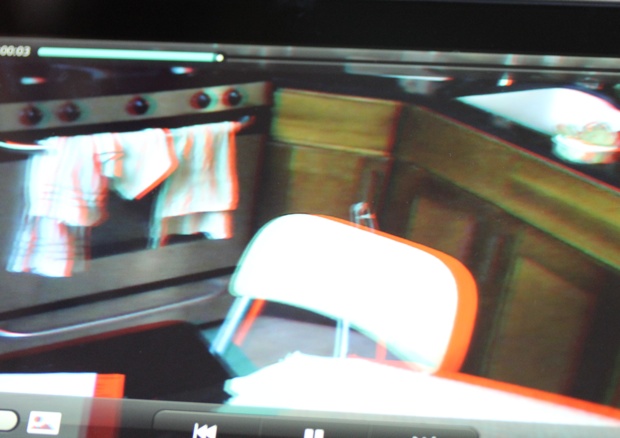
Features:
- 3D Camera
- Android Honeycomb
- Flash Support
- 4G Cellular Networking
- MSRP: $529 with 2 year contract and rebate
Pros:
- Wild 3D video mode
- Excellent cellular connectivity
- Multi-format video/audio support
Cons:
- Some compatibly issues with Android software
- Expensive (with contract)
- Heavy
Old Two Eyes
The Honeycomb slate market is getting crowded. With new devices launching every day and current models getting incremental updates that put them on parity with just about anything else out there, manufacturers gotta have a gimmick.
Like Power Rangers or Reservoir Dogs, Honeycomb tablet manufacturers must depend on one or two defining characteristics to convince a restless consumer base to pick up their devices. Samsung has the thin one, Motorola has the first one, and LG, with its unique and clever G-Slate, has the 3D one. All we need now is the slate for stoners and the pretty one and you’ve got an episode of Scooby Doo. Add in a waterproof one for Gilligan’s Island.
3D aside, the G-Slate is a good, standard Honeycomb tablet. It is thin, portable, and sufficiently light. I was able to get about eight hours of continuous use out of this device. I maxed out at 648 kbsp down/1183kbps up using T-Mobile’s 4G network although your results may vary.
Thankfully, the G-Slate seems to avoid many of the problems that plagued the Xoom. At the very least, the 8.9-inch T-Mobile G-Slate has Flash out of the box and I was able to browse and use many Flash widgets. The Tegra 2 1GHz Dual-Core processor seems to handle everything you could throw at it on that front. However, with the glut of devices still expected in the next few month, how can something like the G-Slate stand out?
What Is This Thing?
The G-Slate is a standard Honeycomb tablet with 8.9-inch 1280 x 800 pixel screen with Wi-Fi and T-Mobile 4G HSPA+ support. It also has a built-in Wi-Fi radio and 32GB of storage. It is 9.6 inches long and .5 inches thick and weighs a surprisingly hefty (for its size) 22 ounces. It is a squat, swart piece of machinery with a glossy black screen and a bit of brushed aluminum styling to add a bit of pizazz to what would otherwise be a fairly staid trade dress.
The gimmicky cameras are dual 5-megapixel shooters (plus LED flash) that are spaced beside the metal strip, making the device look like it has a big, long nose. There is a small access cover that pops off the top to reveal the SIM card slot. There is no MicroSD slot.
The external speakers are loud and bold although there is a headphone jack on the top next to a ridiculous pin-shaped charging port. The device did not charge via USB although there is a USB and HDMI port on the bottom.
There is a front camera. None of the cameras are particularly good but they are, at the very least, fun.
I tested a few Honeycomb and mobile Android apps and found most of them to work correctly. However, a few older Android games and apps failed to run under Honeycomb. And they say there’s no OS fracturing!
The Good
Generally, I like the G-Slate. It’s small, runs Honeycomb, and has built-in 4G networking. The best way I can explain the impression I get from this device is that it’s very much like a big phone. It is very streamlined and the OS/chip combination makes things work quickly and without much lag. When there is a problem, the apps close as opposed to bog down and a task manager would be a boon to fans of multi-tasking on this device.
The Cute

The 3D gimmick is the hardest thing to wrap my head around. The G-Slate actually comes with red and blue glasses to watch 3D video and view 3D images. I think people will use the 3D feature once or twice and then forget about it. You could potentially take the actual 3D video and view it with active shutter glasses on a large screen TV, but this is not an option in the player right now.
Clearly we’re not talking Avatar quality here, but it’s fun.
The Bad
Performance-wise I think the G-Slate is slightly lacking. As many have said before, Honeycomb on a Tegra processor lacks the snap and polish of iOS on its best days and this is partially the hardware manufacturer’s fault and partially Google’s. However, I was impressed that this device did perform as well as it did and although Honeycomb isn’t all there just yet, we can expect updates and improvements over the next year. Devices like the Xoom and G-Slate are, in a sense, future proof for as long as Google maintains the Android 3.X platform.
Again, you’re going to find a bit of lag here but not much and it seems like most of the major issues I found in the Xoom have been ironed out.
Bottom Line
If you’re an Android tablet fan tethered to T-Mobile then this is the device for you. It has a bit more fit and finish than the Xoom and is smaller than the latest Honeycomb entrant, the Acer Iconia A500. At $529 with two year contract and $100 rebate I find this a bit too expensive and, as was just announced, the device sells for a whopping $750 without service.
If you don’t need your Honeycomb fix immediately, however, I suspect we’ll see better-priced and less “gimmicky” devices down the line. The G-Slate is clever and cute but the caveats we mentioned above – especially the lack of SD slot, reduces its usability. However, I can recommend it to folks who are definitely tied to T-Mo and don’t want to spend the cash on a Wi-Fi only model.

